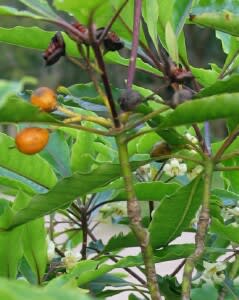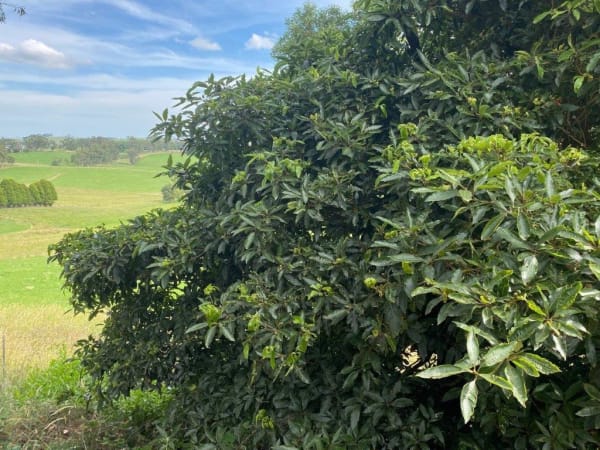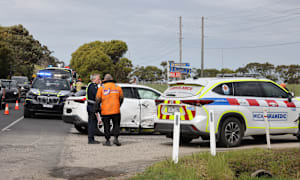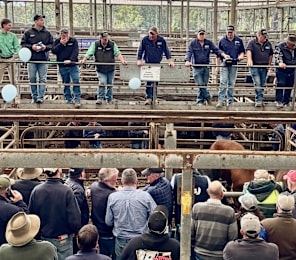
ONCE you’ve seen the proliferation of Sweet Pittosporum across South Gippsland, you can’t unsee it.
It’s everywhere, smothering roadside remnant vegetation, suffocating treasured farm bush blocks, destroying native fauna links and eliminating the diversity of green wedges.
You don’t have to tell Ed Thexton about it.
The President of the South Gippsland Conservation Society has a small native reserve on both sides of his Inverloch property, little more than a hectare in size, and since he moved there in 2011, he has removed “several thousand seedlings each year”. Each year!
Imagine then what’s going on along the roadside and other native bush locations throughout the region where Sweet Pittosporum is multiplying year on year.
“The seeds are well distributed by Currawongs and Blackbirds and they come up everywhere,” said Ed.
“We could do a whole hit piece on Pittosporum,” he said, planning to include a feature on the invasive plant on the conservation group’s new website.
“I experienced it while working in river management in East Gippsland. It’s terribly hard to control, and it’s got to be an annual program not a project.”
Mr Thexton said that single weed species projects, attacking blackberry for example, were all well and good but you have the situation where contractors walked past a variety of weeds to get to the target species.
“It needs a program of education and management that involves everyone; private landowners, government departments, shires, Landcare and community groups, all taking action in concert, and it needs to happen every year.
“Once you’ve hit it hard though, and you know the problem areas, it can be controlled more efficiently with less and less chemicals.
“Roadsides are one of the worst affected areas and hardest to control. We did a program at Ayre Creek with $10,000 funding from Vicroads and most of it went on chippers, chainsaws and traffic management. Where you are targeting roadside vegetation, you have to manage the traffic which can be a costly undertaking.”
The Wonthaggi Seedbank and Nursery is alive to the problem, and they feature a warning on their website, while promoting a wide range of more suitable natives.
“Sweet Pittosporum is a plant that historically has been planted for ornamental purposes, hedging and screening. It can grow to 15m tall and forms a dense canopy with significant foliage that shades the ground and drops lots of leaves. A chemical inhibitor in the leaves starves surrounding plants. Seeds (when ripe the berries are bright orange) are spread by fruit-eating birds and commonly through our water ways. Unfortunately, the species has also proven to be very invasive in bushland and is classified as an environmental weed across our region.
“It’s a major problem, especially in our established bushland areas. It’s one of the few plants that can invade an intact system,” said Chris Owens of the Wonthaggi Seedbank.
“It can grow in dense shade and out-compete with all vegetation around it, spreading out, shutting out the light and choking everything around it to produce a monoculture.
“It used to be sold commercially, up until the 1980s and 90s, and there’s plenty of it about in the urban setting as well.
“If you’ve got mature trees around you, the seeds would be positively raining down on you at certain times of the year,” he said.
Did you know?
* This plant is NOT permitted in your tip green waste to avoid re-infestation through mulching.
* This plant CAN BE disposed of in the organics bin (green lid) that the council provides or at your local Transfer station.

How can you become part of the solution?
Target fruit bearing plants first, cut as close to the ground as possible and immediately paint with poison. It will take some effort if it is well established.
The Victorian Indigenous Gardeners posted some information that may prove helpful: Best methodology for big ones is to frill and fill using diluted glyphosate (label says 1:12). If you’re removing the biomass from the site, by all means cut and paint the stump but just dropping the tree can damage any ground flora etc, that the tree falls onto. The allelopathic (toxic to other plants) nature of even the dead leaves are best kept inside the original drip line of the tree. Leaving the tree standing is better for habitat outcomes and site carbon retention. Unsightly dead “Pittosporum skeletons” are the least of our worries. They fall down pretty quickly.
South Gippsland Landcare Network says this about the environmental weed Sweet Pittosporum: “Pittosporum Uundulatum occurs naturally throughout much of Gippsland. Produces masses of sweet-scented flowers in spring which develop into orange berries in autumn. Has become very invasive along roadsides and bushland out competing other natives. It is bBecoming more widespread due to altered drainage patterns, reduced fire frequencies and increased dispersal by birds. Also westward distribution due to popularity as a garden plant. Sweet Pittosporum has dense foliage which reduces light levels which effects the composition of ground flora and leaf litter altering soil chemistry.
Manual control: Small plants can be hand pulled. Larger plants can be mechanically removed with a woody weed puller.
Chemical control: Cut and paint with Round Up or Vigilant Gel. Frill and fill with Round up. Always check the herbicide label before use.










